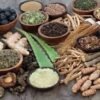Introduction
Sensitive skin requires a delicate balance of care. Often, conventional skincare products can irritate, inflame, or worsen sensitivity. In such cases, the holistic and natural methods of Ayurveda offer an alternative. Ayurveda, an ancient system of medicine, emphasizes personalized care by understanding an individual’s unique constitution, or dosha. Therefore, using Ayurvedic principles to care for sensitive skin not only addresses the symptoms but also targets the root causes, bringing balance to the body and mind. In this article, we will explore Ayurvedic approaches to managing and nurturing sensitive skin, including herbal remedies, dietary adjustments, and lifestyle practices.
Understanding Sensitive Skin in Ayurveda
In Ayurveda, sensitive skin is often associated with an imbalance in the Pitta and Vata doshas. Pitta dosha governs heat and metabolism, and when imbalanced, it can lead to skin that is prone to redness, inflammation, and rashes. On the other hand, Vata dosha, which controls movement and dryness, can cause flaky, dry, and irritated skin when out of balance. Consequently, sensitive skin is typically a combination of these two doshas, characterized by inflammation, dryness, and irritability.
Ayurveda approaches sensitive skin care by focusing on pacifying these doshas and restoring balance within the body. Instead of treating just the symptoms, the goal is to address the underlying factors contributing to the skin’s sensitivity, whether it be stress, improper diet, or environmental influences.
Ayurvedic Remedies for Sensitive Skin
1. Aloe Vera (Ghritkumari)
To begin with, Aloe Vera is one of the most soothing and cooling Ayurvedic remedies for sensitive skin. It has anti-inflammatory and healing properties that help reduce redness, itching, and irritation. Moreover, Aloe Vera is gentle and can be used on even the most reactive skin types.
Why It Works: Aloe Vera’s cooling effect helps to balance the Pitta dosha, which is often responsible for redness and irritation in sensitive skin. Its moisturizing properties also help alleviate dryness caused by an imbalanced Vata dosha.
How to Use It: Apply fresh Aloe Vera gel directly to the skin or use products that contain high concentrations of pure Aloe Vera. Regular application can calm inflamed skin and provide relief from irritation.
2. Sandalwood (Chandan)
Next, Sandalwood is another key ingredient in Ayurvedic skincare for sensitive skin. Known for its cooling and soothing properties, it is often used to treat inflammation, rashes, and acne, all of which are common in sensitive skin types.
Why It Works: Sandalwood helps cool the Pitta dosha and reduce heat in the skin, which is beneficial for those with sensitivity and inflammation. Additionally, it has antimicrobial properties that help protect the skin from infection.
How to Use It: Mix Sandalwood powder with rose water to create a calming face mask. Apply the mask once or twice a week to soothe sensitive skin and reduce inflammation.
3. Turmeric (Haldi)
Furthermore, Turmeric is a powerful anti-inflammatory and antioxidant that can help sensitive skin by reducing redness and irritation. Its active compound, curcumin, has been extensively studied for its ability to calm inflamed skin and promote healing.
Why It Works: Turmeric balances both Pitta and Vata doshas, making it ideal for treating the mixed symptoms of sensitive skin. In addition, its anti-inflammatory properties help reduce redness, while its antioxidants fight free radicals that can further damage sensitive skin.
How to Use It: Add a pinch of turmeric powder to your daily meals or mix it into a paste with milk or honey for a topical treatment. Regular use can brighten the skin and reduce sensitivity over time.
Ayurvedic Dietary Tips for Sensitive Skin
Ayurveda emphasizes that external treatments are only part of the solution. What you consume also plays a critical role in skin health. Sensitive skin, particularly due to Pitta and Vata imbalances, can be exacerbated by certain foods. Therefore, adjusting your diet to pacify these doshas can significantly improve skin condition.
1. Favor Cooling and Hydrating Foods
Sensitive skin, especially if prone to redness and inflammation, can benefit from cooling foods that reduce internal heat. For instance, cucumbers, melons, and leafy greens are excellent choices for pacifying Pitta. Additionally, foods that are hydrating and lubricating, such as coconut water and ghee, help to counterbalance Vata dryness.
Why It Works: Cooling foods reduce the internal heat that can manifest as skin inflammation and redness. At the same time, hydrating foods help maintain skin moisture, which is crucial for sensitive skin prone to dryness and irritation.
How to Implement It: Incorporate more raw fruits and vegetables into your diet, particularly those with cooling properties. Coconut water, in particular, is highly recommended as it hydrates the skin and cools the body.
2. Avoid Spicy, Sour, and Processed Foods
Conversely, foods that increase Pitta, such as spicy and sour foods, should be avoided as they can trigger or worsen skin sensitivity. Processed foods, which are often dry and difficult to digest, can aggravate Vata dosha, leading to dryness and irritation.
Why It Works: Avoiding these foods helps prevent further imbalance in the doshas, thus reducing the likelihood of skin flare-ups. By minimizing heat-inducing and drying foods, sensitive skin is less likely to experience inflammation and irritation.
How to Implement It: Opt for milder flavors in your cooking, using herbs like cilantro and mint instead of hot spices. Replace processed snacks with whole, nourishing foods that are easier for the body to digest.
Ayurvedic Lifestyle Practices for Sensitive Skin
Beyond diet and topical treatments, Ayurveda encourages certain lifestyle practices to support overall skin health. These practices help reduce stress, enhance circulation, and promote the detoxification of the body, all of which are essential for managing sensitive skin.
1. Abhyanga (Oil Massage)
Abhyanga, the Ayurvedic practice of self-massage using warm oil, is especially beneficial for sensitive skin. Using oils like sesame or coconut helps nourish the skin, improve circulation, and calm the nervous system. Moreover, it hydrates the skin from the outside, making it less prone to irritation and dryness.
Why It Works: Regular oil massage helps to pacify Vata dosha by providing the skin with necessary moisture. It also has a calming effect on the nervous system, which can reduce stress-related skin sensitivity.
How to Implement It: Warm the oil and gently massage it onto your skin for 15-20 minutes before bathing. This practice can be done daily or at least a few times a week to nourish the skin and calm the mind.
2. Stress Management Techniques
Stress is a major trigger for sensitive skin. Practices such as yoga, meditation, and pranayama (breath control) are essential parts of Ayurveda that help balance the mind and body, thereby reducing skin flare-ups caused by stress.
Why It Works: Reducing stress levels helps balance the Pitta and Vata doshas, which are often aggravated by emotional and mental tension. As stress levels decrease, skin inflammation and sensitivity tend to improve as well.
How to Implement It: Dedicate at least 10-15 minutes each day to practicing meditation or pranayama. These practices help calm the mind, reduce stress hormones, and promote overall skin health.
Transitioning to an Ayurvedic Routine for Sensitive Skin
Transitioning to an Ayurvedic skincare routine involves both internal and external adjustments. Start by incorporating Ayurvedic herbs and superfoods into your diet and gradually replace harsh skincare products with natural, gentle alternatives. Moreover, adopting lifestyle practices such as Abhyanga and meditation will help you nurture your sensitive skin holistically.
Consistency is key when following Ayurvedic principles. Unlike quick fixes, Ayurveda emphasizes long-term care and balance, so it may take time to notice significant improvements. However, by committing to an Ayurvedic approach, you will likely find that your skin becomes less reactive and more resilient over time.
Harnessing the Power of Ayurvedic Herbs for Modern Beauty Routines
Conclusion
In conclusion, Ayurvedic approaches to sensitive skin care offer a holistic, natural solution for those struggling with irritation, inflammation, and dryness. By balancing the Pitta and Vata doshas through the use of herbal remedies, dietary adjustments, and lifestyle practices, you can effectively manage sensitive skin. Aloe Vera, Sandalwood, and Turmeric are just a few of the Ayurvedic ingredients that soothe and heal the skin, while a diet rich in cooling, hydrating foods further supports skin health. When combined with stress-reducing techniques like yoga and Abhyanga, these practices create a comprehensive regimen for sensitive skin, fostering not just external beauty but internal balance as well.




Leave a reply